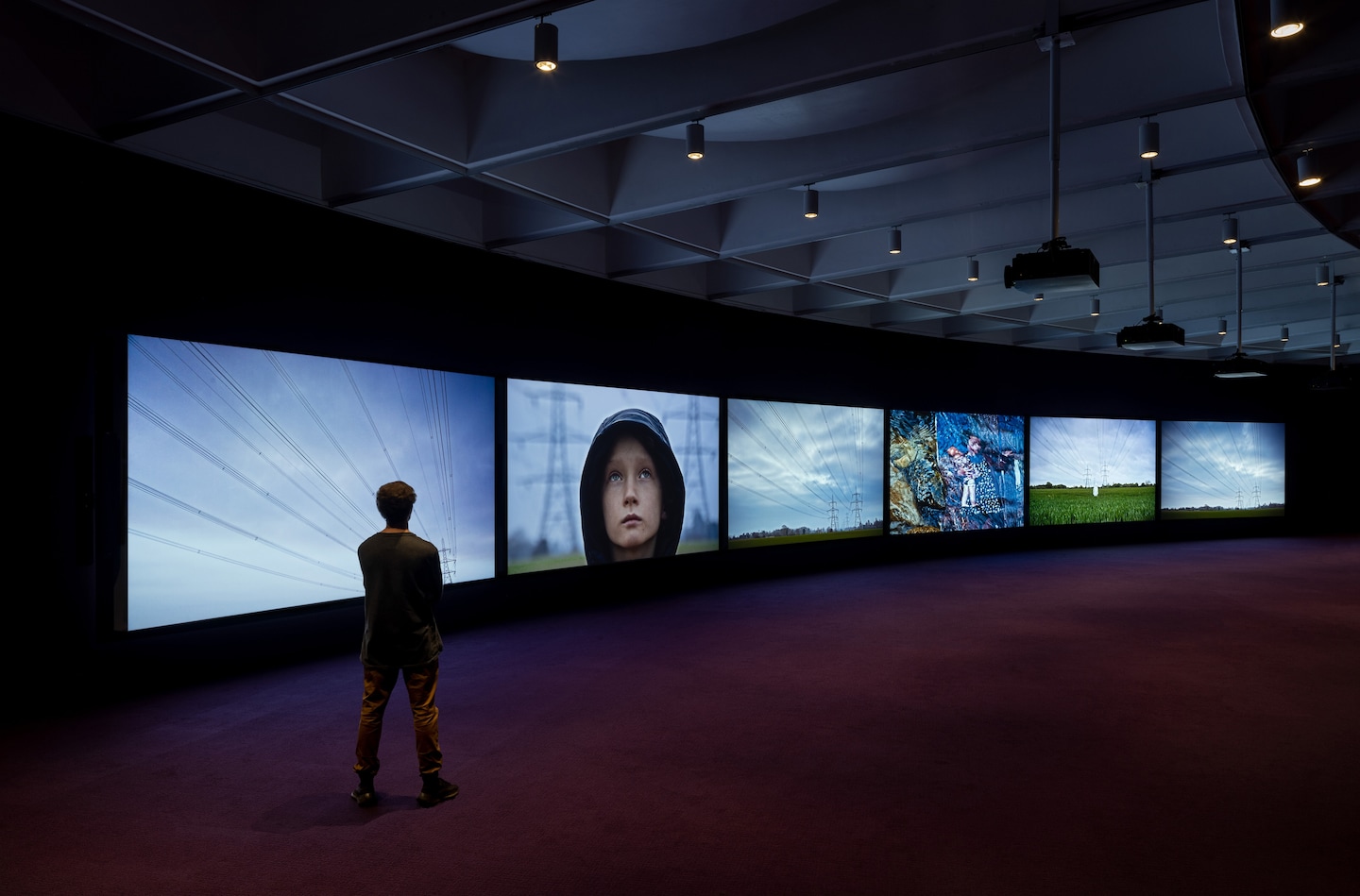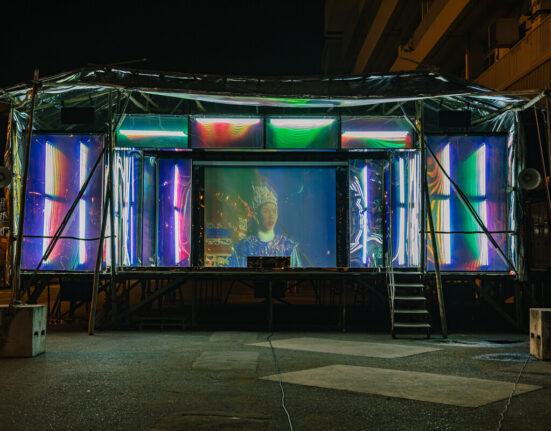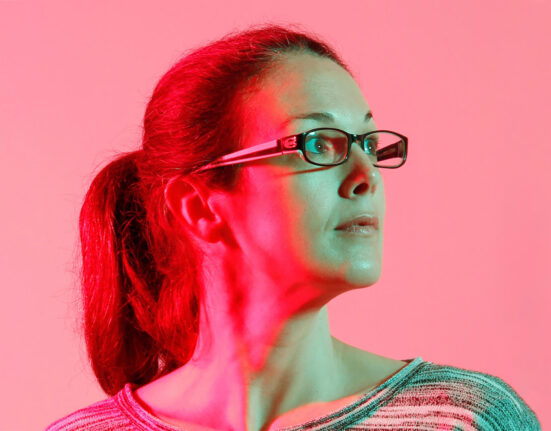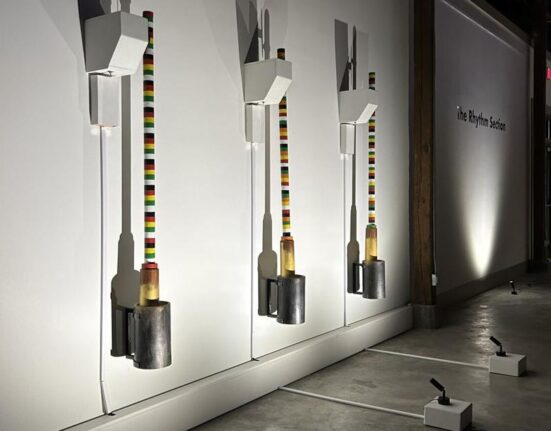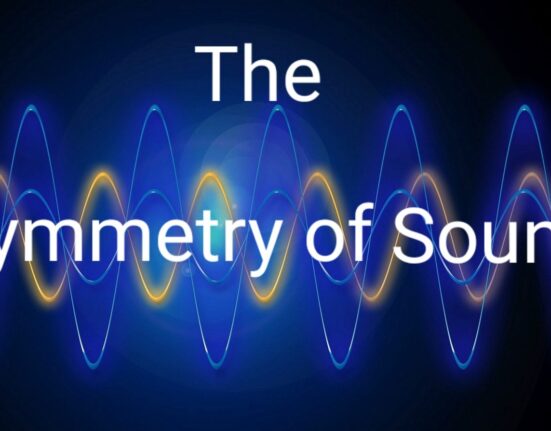One specific reference is woven through many of the British Ghanaian filmmaker’s works: “Wanderer Above the Sea of Fog,” the essential painting by Caspar David Friedrich, from around 1817. It depicts a ginger-haired gentleman in a lush green overcoat, clutching a walking stick and peering out from a rocky promontory. Misty rolling hills trail off in the distance. This painting points to true north on the romantic’s compass: To explore the self means to seek the sublime.
Akomfrah’s cinematic installations summon the same rich interior relationship with nature. It’s more than a vibe: Akomfrah is working to reconcile 19th-century romantic aesthetics with 21st-century collectivist problems. For a project indebted to history and theory, Akomfrah’s works are nothing less than mesmerizing.
“Purple” is Akomfrah’s most immense video installation to date. Comprising six screens, the 2017 piece occupies an entire minor arc of the ring-shaped Hirshhorn Museum and Sculpture Garden. Throughout the film — or films, since watching “Purple” requires a viewer to take in all six screens simultaneously — Akomfrah pairs contemporary footage from voyages to remote locales with historical clips from factories, mines and other industrial settings. The message is as simple as it is urgent: The Anthropocene era is putting the natural sublime at risk.
Curated by Marina Isgro, the roughly hour-long work is subdivided into five movements, which proceed like a symphony. Visual themes surface and repeat over the course of the piece: an overhead view of the bow of a ship, for example, as it makes a rapid clip across the water. (The actual soundtrack is a soothing ambient score by British composers Tandis Jenhudson and David Julyan.) Footage shot in Alaska and Greenland (among other sites) finds one solitary figure after another, dressed in a sturdy white jacket, surveying the immensity of these Arctic reaches.
Akomfrah puts down a few explicit literary markers. One of many cryptic titles that flash across the screens reads, “O earth what changes hast thou seen!,” a line from a sprawling 1850 poem, “In Memoriam,” by Alfred, Lord Tennyson. But for the most part, the artist tells his story through atmosphere. Utility pylons stand as a metaphor for the reach of industry across the landscape. Nuclear cooling towers mirror the majesty of Arctic mountain ranges. Sled dogs evoke both the resilience of Indigenous communities and the larger-than-life explorers of the 19th century, while scenes of poisoned landscapes reveal the eventual corruption of the heroic narrative.
For an indictment of climate change and colonialism, Akomfrah’s message is nuanced. Among the historical clips of industrial laborers dredging up resources or Alaska energy officials divvying up the territory are scenes of workers singing beautiful, indiscernible laments. This is a stolidly pro-labor film. Yet the medium — the sensational totality of Akomfrah’s crisp editing, gorgeous photography and enveloping presentation — cuts against the grain of critique. Even at its rawest moments, “Purple” is almost suspiciously beautiful.
“Five Murmurations,” a 2021 work by Akomfrah on view at the National Museum of African Art, takes on another steep social provocation. Curated by Karen E. Milbourne, this hour-long, three-channel video represents the artist’s summary of a tumultuous 18-month period stretching from late 2019 to early 2021, encapsulating the twin traumas of the coronavirus pandemic and police brutality.
Akomfrah begins, naturally, with a painting from Western art history, this time Hieronymus Bosch’s “The Conjurer” (circa 1502). A relatively mild work by Bosch — the smutty poet laureate of Pandemonium — the painting shows a magician who enthralls a crowd with a shell game while a cutpurse relieves an onlooker of his wallet. It’s something of a non sequitur for “Five Murmurations,” which also features Andrea Mantegna’s “The Lamentation Over the Dead Christ” (1480s), an utterly physical quattrocento painting that speaks pointedly to the police killings of Breonna Taylor and George Floyd. Mantegna sought to show the physical violence of the crucifixion by painting Christ’s body, dead on a slab, the stigmata of his feet confronting the viewer: a reminder that Jesus was a man killed by the state.
While it would seem like old hat for the 8-billion-odd people who survived covid-19, Akomfrah returns to those early weeks of the pandemic and captures a vivid sensation of that unsettling time. It’s a simple sequence: Amid narrow shots of maps and charts, the visual artifacts of the pandemic as it unfolded, the artist inserts scenes of people cooking meals at home. It’s a faithful yet evocative gloss of those days of uncertainty and isolation, when it seemed like the only thing to do was to hit refresh on various counters that only grew more alarming as the danger drew nearer. Akomfrah finds an essential metaphor for that harrowing blur of data and despair in murmurations of birds, patterns of movement too chaotic to trace.
With his absorbing cinematics, Akomfrah is something of a conjurer himself. Not a con artist, but a spellbinding storyteller who is able to suggest a political ideal without being (too) explicit. There is a danger to an immersive video installation such as “Purple,” which takes a format so arresting, so alluring, that it threatens to obscure any message an artist might hope to convey. Akomfrah trusts in the romantic way: What rhetoric cannot register, only poetry can deliver, only the spirit can receive and only nature can convey.
Hirshhorn Museum and Sculpture Garden, Independence Avenue and Seventh Street SW. hirshhorn.si.edu.
National Museum of African Art, 950 Independence Ave. SW. africa.si.edu.
Admission: Free for both.

